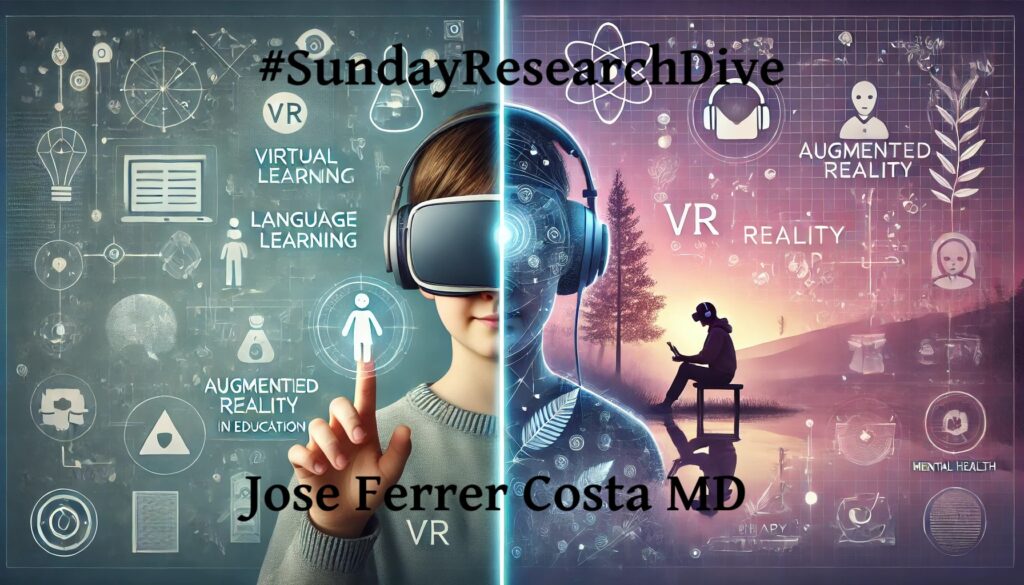
This Sunday, we examine the role of immersive technologies in education and therapy for individuals with disabilities. Our focus is on three recent studies that highlight the practical applications of Virtual Reality (VR) and Augmented Reality (AR).
🚀 Study Overviews:
1. “Immersive virtual reality is more effective than non-immersive devices for developing real-world skills in people with intellectual disability” by A. Franze et al.
- This study investigates the effectiveness of immersive VR compared to non-immersive devices in teaching real-world skills to individuals with intellectual disabilities.
- Conducted with 36 participants over several training sessions, the study focused on practical tasks like waste management.
- The findings indicate that immersive VR significantly enhances learning outcomes by providing hands-on interaction in a controlled, realistic setting, which is essential for skill retention and application.
🔗 Dive deeper: https://pubmed.ncbi.nlm.nih.gov/39169557/
2. “Developing and evaluating an immersive augmented reality application for children with developmental communication disability: InterPlay for language learning” by Lucy Bryant et al.
- This study focuses on the development and evaluation of an AR application to support language development in children with developmental communication disabilities.
- It involved a total of eight experts in its expert reference group recruited from various fields.
- The paper emphasizes the importance of expert consultation and participatory design in creating AR technologies tailored to the needs of children with communication disabilities.
🔗 Dive deeper: https://pubmed.ncbi.nlm.nih.gov/39135408/
3. “Effects of virtual reality-based cognitive training for adolescents with depressive episodes: A pilot randomized controlled study” by Sihui Lyu et al.
- This pilot study evaluates the impact of VR-based cognitive training on adolescents experiencing depressive episodes.
- Including 47 adolescents with depressive episodes in the VR training group and 46 in the waitlist control group, conducted over a 7-week period with 20 sessions of VR training.
- Results suggested that VR interventions could significantly enhance cognitive skills and emotional regulation, highlighting VR’s potential as a tool for mental health treatment.
🔗 Dive deeper: https://pubmed.ncbi.nlm.nih.gov/39167866/
📊 Key Insights:
1. Enhanced Learning through Immersion
- Immersive VR significantly outperforms non-immersive environments by providing hands-on, realistic interactions that better facilitate the acquisition and retention of life skills in people with intellectual disabilities.
2. Interactive Tools for Language Development
- The development of augmented reality applications for language learning in children with developmental communication disabilities benefits greatly from expert consultation and participatory design. Although direct testing with children was not conducted, the study emphasizes how carefully designed AR tools can enhance engagement and be more effective in developing communication skills when aligned closely with user needs.
3. VR as a Therapeutic Modality
- VR-based cognitive training demonstrates promise as an effective intervention for adolescents with depressive episodes. The study found that VR could improve cognitive functions and emotional well-being, suggesting its potential as a supplementary tool in mental health treatment for this demographic.
🧐 Reflections:
The studies highlight the significant potential of VR in enhancing educational and therapeutic interventions, especially for populations that do not respond well to traditional methods. VR’s capability to create realistic and immersive environments is particularly beneficial for individuals with intellectual disabilities and those experiencing mental health issues like depression, where conventional approaches may lack engagement and effectiveness.
For these groups, VR offers a tailored, interactive experience that can adapt to different levels of ability and learning styles, making both education and therapy more accessible and impactful. By allowing customization in complexity and pacing, VR ensures that interventions are more aligned with each user’s unique needs, maximizing the benefits of these technologies.
⚖️ Discussion on Technology Use:
1. Safety and Effectiveness:
- While VR and AR can enhance engagement and learning, it is important to consider potential side effects, such as cybersickness and cognitive overload. Proper management and design modifications are necessary to minimize these risks.
- Recent studies, such as those by Smith et al. and Jones et al., explore the causes and mitigation strategies for cybersickness, highlighting the need for ongoing research and careful design to minimize these effects.
2. Accessibility and Customization:
- Despite the benefits, high costs and technical complexity can limit the accessibility of VR and AR technologies. Efforts to reduce costs and simplify interfaces are crucial to making these tools more widely available.
3. Integration and Training:
- VR and AR should be used as supplements to traditional educational and therapeutic methods rather than replacements. Effective integration requires training and support for educators and therapists to ensure these technologies are used to their full potential.
4. Future Prospects and Ethical Considerations:
- As these technologies evolve, it is essential to maintain ethical standards in their application. Continuous research is needed to assess long-term effects, optimize their use, and ensure they meet diverse needs responsibly and effectively.
💡 Looking Ahead:
As VR and AR become more integrated into therapy and education, continuous evaluation will be essential to refine their use and maximize their benefits. These technologies have the potential to support and enhance traditional approaches in meaningful ways.
#ImmersiveTech #Education #Therapy #SundayResearchDive
This article was originally published on vrforhealth
